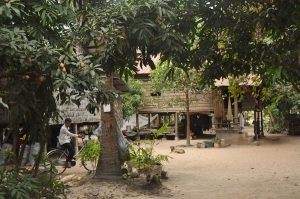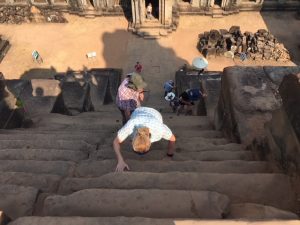The journey from Vietnam to Cambodia passed without any hitches. Acquiring our entry visas was much more straight forward than it had been entering Vietnam. We came out of the airport to be met by Sophey, our Siem Reap guide. The drive from the airport towards the town revealed a much drier landscape to those we had seen in Vietnam. The fields were covered largely with a post-harvest stubble. On the way to our hotel we stopped off by a large hotel complex to pick up our entrance pass for the many historical sites we were to visit. Sophey recommended we do this now rather than in the morning when the queues can be very long and slow. He was right, we sailed through.
We were staying in the Central Boutique Hotel in the heart of Siem Reap, a town that has grown around the world’s desire to see Angkor Wat. The town was established by the French in the early part of the 20thC, but fell into decline during the 1960s when Cambodia became unwillingly embroiled in the Vietnam War, before experiencing its own civil war, more years of persecution at the hands of Pol Pot and then years of political instability as it tried to rescue and rebuild itself. It wasn’t really until the new millennium that tourism began to return and Siem Reap was able to grow and develop for an increasingly buoyant tourist trade.
We knew we had arrived in a warm country for the reception, bar and restaurant area of the hotel was open at the sides to the elements. Pools of carp separated one area from another. Everything centred on to well-tended gardens with flowering shrubs that attracted butterflies. Two pools were hidden in the gardens. It was hot!
Later that afternoon Sophey collected us to take us to a massage centre where we were to be treated to a massage of our choice – full body, head, neck and shoulders or lower leg and foot. Couples were ushered into rooms together while in others men were grouped together and women were similarly grouped. Wearing loose fitting pyjamas I was pummelled, pulled and twisted for an hour. It was the most incredible massage and I felt so good afterwards. It seems everybody benefited from the experience.
Following the massage, we went off to a family house for dinner. There we met the whole family who cooked and served us a delightful meal while sitting on cushions around a low table.
I slept really well that night and I can only attribute that to the effects of the massage. Perhaps, I might have to have another before I leave Cambodia.
The next morning Sophey came to meet us at the hotel for our day of temple bagging. He carried with him a selfie stick with a rabbit dangling from it. “Follow the rabbit.” Initially, we were due to go to Angkor Wat first, but he assured us that it would be very busy, particularly with lots of Chinese groups who would spoil it for us. He advised us that if we left it until after 11.30am it would be much quieter as the Chinese all go off for lunch from then until about 2.00pm. We bowed to his superior knowledge and his suggestion to visit Banteay Samre Temple first.
The history of these many temples is quite complex and difficult to take in when you are there. You are more consumed by the sheer beauty of them that the stories surrounding them get forgotten. They all stem from about 800AD when a huge building project came about. They were not only temples but also homes to many people that came under their jurisdiction. Angkor Wat, was for example, the world’s first mega city, probably having a population in excess of one million, although that has not yet been ascertained to be true. Initially, they were built as Hindu temples, but the emphasis of religion changed with peoples’ desires and they went through a phase of being Buddhist, returning to Hinduism and in the 14thC returning again to Buddhism.
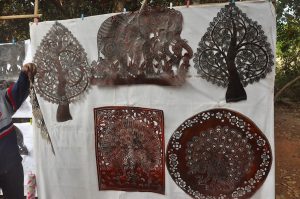 We approached Banteay Samre via a wide track with trees on either side. There were the occasional stalls selling beautiful leather cut-out pictures of trees and elephants. I would have liked to give them more attention, but I felt confident that we would see more examples at a more appropriate time to buy. Likewise, with some beautiful paintings also for sale. Also, on this walk to the temple we came across a small musical group sitting on a dais playing lovely music. They were all victims of conflict and had one form of disability or another. Their disability did not stop them making beautiful music.
We approached Banteay Samre via a wide track with trees on either side. There were the occasional stalls selling beautiful leather cut-out pictures of trees and elephants. I would have liked to give them more attention, but I felt confident that we would see more examples at a more appropriate time to buy. Likewise, with some beautiful paintings also for sale. Also, on this walk to the temple we came across a small musical group sitting on a dais playing lovely music. They were all victims of conflict and had one form of disability or another. Their disability did not stop them making beautiful music.
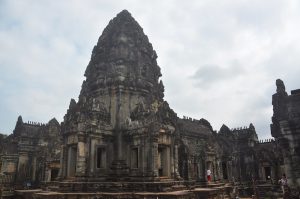 The temple is named after the Samre, an ancient ethnic tribe closely related to the Khmers. Banteay is the Khmer word for citadel. On reaching the temple we discovered that it is not one of the larger ones, but a tightly compact temple with a single tower in the middle. Around the tower is an inner wall with doorways on each side. Then a grassed area, which was probably a moat, before an outer wall with matching doorways. The grey stonework is intricately carved and fearsome beasts stand on guard protecting it from unwanted visitors, or they would if they had not, largely, been decapitated, or had their faces removed by looters. I was particularly fascinated by the carved, circular pillars that covered the windows. They were very intricate and were so well done that it was hard to believe they had not been shaped by machine. We were lucky as we virtually had the whole place to ourselves; there were very few other visitors.
The temple is named after the Samre, an ancient ethnic tribe closely related to the Khmers. Banteay is the Khmer word for citadel. On reaching the temple we discovered that it is not one of the larger ones, but a tightly compact temple with a single tower in the middle. Around the tower is an inner wall with doorways on each side. Then a grassed area, which was probably a moat, before an outer wall with matching doorways. The grey stonework is intricately carved and fearsome beasts stand on guard protecting it from unwanted visitors, or they would if they had not, largely, been decapitated, or had their faces removed by looters. I was particularly fascinated by the carved, circular pillars that covered the windows. They were very intricate and were so well done that it was hard to believe they had not been shaped by machine. We were lucky as we virtually had the whole place to ourselves; there were very few other visitors.
Leaving Banteay Samre, we headed off to our next temple, but before doing so we stopped at a small roadside market place to watch the women there turning sugar cane into a sweet, gooey toffee by heating it in a wok over a wood fire. When it was ready they would pour the liquid sugar into moulds made out of thin strips of bamboo so that it would set in sweet sized pieces. Sophey talked us through the process. We had a little time to explore the stalls that sold a wide range of foodie and craft products. Behind the stalls were tidy wooden houses on stilts with fruit trees in between. The dusty earth had been swept, giving it a cared for look and made it look very attractive.
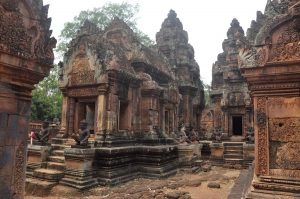 Banteay Srei Temple, which translates to citadel of women or citadel of beauty, is dedicated to the Hindu God, Shiva. It is largely built out of red sandstone, and, as such, lends itself to lots of intricate stone carving. The detail and complexity of the stone carving is phenomenal. It also struck me as having much more detail in its structure, not being limited to just one, single tower in the middle. There were three, although they were not as large as the single tower at Banteay Samre. In fact, everything about this temple seemed to be on a slightly smaller scale, and that might have something to do with the fact that it celebrated women.
Banteay Srei Temple, which translates to citadel of women or citadel of beauty, is dedicated to the Hindu God, Shiva. It is largely built out of red sandstone, and, as such, lends itself to lots of intricate stone carving. The detail and complexity of the stone carving is phenomenal. It also struck me as having much more detail in its structure, not being limited to just one, single tower in the middle. There were three, although they were not as large as the single tower at Banteay Samre. In fact, everything about this temple seemed to be on a slightly smaller scale, and that might have something to do with the fact that it celebrated women.
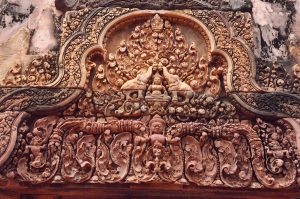 Most of the carvings were still very intact, including the guards around the central part of the temple. I found this temple more attractive and interesting.
Most of the carvings were still very intact, including the guards around the central part of the temple. I found this temple more attractive and interesting.
We had spent longer at these two temples than, perhaps, Sophey had intended, so he made a suggested change to the day’s plans. If we were to have lunch and then go to Angkor Wat we would encounter the afternoon crowds. His alternative suggestion was that we went out to Tonle Sap Lake on a boat trip to visit the floating village. That is what we chose to do.
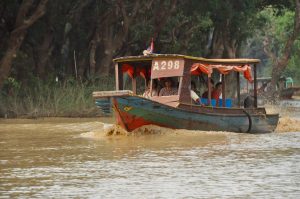 Driving out to a narrow finger of the lake we came across hundreds of boats beached at the water’s edge. The water level was lower than normal, and all the boats were too far out of the water to be any use. We continued to drive further along the finger of water until we came to some boats that that had sufficient water to get going, although it proved to be less than straight forward. The lake at this point is incredibly muddy and the propeller, on the end of a long rod, churned up lots of brown water.
Driving out to a narrow finger of the lake we came across hundreds of boats beached at the water’s edge. The water level was lower than normal, and all the boats were too far out of the water to be any use. We continued to drive further along the finger of water until we came to some boats that that had sufficient water to get going, although it proved to be less than straight forward. The lake at this point is incredibly muddy and the propeller, on the end of a long rod, churned up lots of brown water.
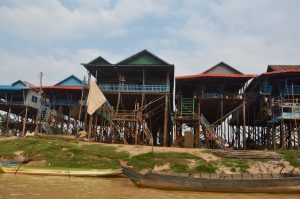 Once we were under way the channel of water weaved its way through a stilted village. The houses were at least 15 feet above ground level. During the rainy season the water comes a long way up the wooden stilts. There was a confusion of wooden stilts and posts. All along the bank were fishing boats with men mending their nets or fixing their boats before their next excursion on to the lake. It was quite a large village and it went on for some considerable distance.
Once we were under way the channel of water weaved its way through a stilted village. The houses were at least 15 feet above ground level. During the rainy season the water comes a long way up the wooden stilts. There was a confusion of wooden stilts and posts. All along the bank were fishing boats with men mending their nets or fixing their boats before their next excursion on to the lake. It was quite a large village and it went on for some considerable distance.
Eventually, the finger of water opened out and we were on a vast expanse of water. The opposite shore was a long way beyond the horizon. Dotted about on the lake were floating houses anchored to the lake bed. Boats bobbed about around them. Elsewhere fishing boats went about their business.
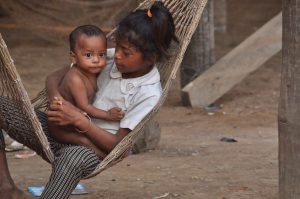 It was not long before we turned around and headed back but instead of going back to where we started the boat dropped us off on the lake side of the village so that we could walk through and see life from the street. And all life is on the street, or, if not on the street, then hanging from balconies or under the houses. Women and children waved to us as we passed while the men were more reserved. Barbecues cooking skewers of meat and fish sent an aroma around the village. Tiny prawns dried on plastic sheets at the side of the road. Hammocks swung gently as villagers relaxed in the late afternoon sun. Children played cheerfully.
It was not long before we turned around and headed back but instead of going back to where we started the boat dropped us off on the lake side of the village so that we could walk through and see life from the street. And all life is on the street, or, if not on the street, then hanging from balconies or under the houses. Women and children waved to us as we passed while the men were more reserved. Barbecues cooking skewers of meat and fish sent an aroma around the village. Tiny prawns dried on plastic sheets at the side of the road. Hammocks swung gently as villagers relaxed in the late afternoon sun. Children played cheerfully.
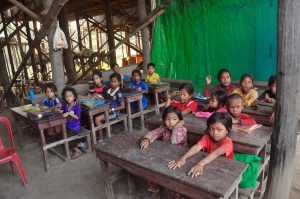 About half way down the village I was accosted to buy a packet of exercise books and pencils. The money would go to support the school, which I discovered was taking place underneath one of the houses. Having bought the books and pencils, I now presented them to the teacher. I wonder how many times they have been bought and presented to the teacher? The class that was taking place was an English lesson and the children were learning their colours through recitation and repetition. I was desperate to get involved. They were learning their colours without any reference to objects of those colours. Unfortunately, they looked a little shocked when I tried to get involved as if they were not used to animated teaching. I learnt that this is an extra school that takes place after the end of the normal school day, a time where children can learn English, to, hopefully, give them a head start in life.
About half way down the village I was accosted to buy a packet of exercise books and pencils. The money would go to support the school, which I discovered was taking place underneath one of the houses. Having bought the books and pencils, I now presented them to the teacher. I wonder how many times they have been bought and presented to the teacher? The class that was taking place was an English lesson and the children were learning their colours through recitation and repetition. I was desperate to get involved. They were learning their colours without any reference to objects of those colours. Unfortunately, they looked a little shocked when I tried to get involved as if they were not used to animated teaching. I learnt that this is an extra school that takes place after the end of the normal school day, a time where children can learn English, to, hopefully, give them a head start in life.
Eventually, aware that the rest of the group were waiting for me at the end of the village, I dragged myself away, but would have loved to have had more time to get involved, to roll my sleeves up, and give the children a lesson they wouldn’t forget.
At the end of the village a new temple stood proudly. We had been told how poor this community was and how their lives depended so heavily on good fishing, boat building and repairs, agriculture, and tourism. They not only live on the edge of the lake but also on the edge of economic survival. How the temple was funded I don’t know, but I expect the fact that there is a community of monks, that the funding came from elsewhere.
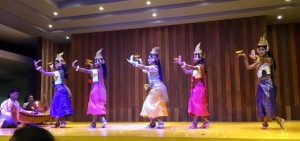 The bus was waiting for us as we left the village and took us back to Siem Reap. After a quick tidy up we were taken to a restaurant theatre for dinner and a cultural show. Both were excellent. It was remarkable how the female dancers could naturally bend their fingers the wrong way. The male dancers were very athletic. It was an enjoyable end to a very full day.
The bus was waiting for us as we left the village and took us back to Siem Reap. After a quick tidy up we were taken to a restaurant theatre for dinner and a cultural show. Both were excellent. It was remarkable how the female dancers could naturally bend their fingers the wrong way. The male dancers were very athletic. It was an enjoyable end to a very full day.
Another hot, sunny morning greeted us for our last full day in Siem Reap. Today was going to be another full day of temples, with potentially the best to come. Sophey greeted us after breakfast and we headed for the bus to take us to Ta Prohm. However, on the way we exchanged our large bus for a much smaller one that could take us to the various sites. Stone gateways straddle the roads around Angkor Wat that are too narrow for large buses. It was a bit of a tight squeeze.
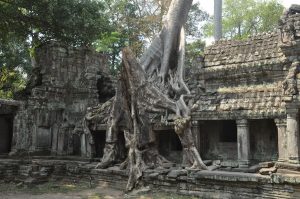 Unlike a lot of the temples, Ta Prohm has been left very much as it was found, with large trees growing out of the ruins, spreading their roots, serpent like, between and around the stones. Some restoration work is going on but the trees are, largely remaining untouched.
Unlike a lot of the temples, Ta Prohm has been left very much as it was found, with large trees growing out of the ruins, spreading their roots, serpent like, between and around the stones. Some restoration work is going on but the trees are, largely remaining untouched.
This temple, understandably, was busier than those we visited yesterday. Unfortunately, the majority of visitors were Chinese and they made no bones about making their presence felt. They were noisy, pushed their way around, took control of photographic high spots by having numerous selfies and portraits taken. They were just impossible. I watched one woman walk around the whole temple looking at it through the screen of her tablet. Not once did she look up. Perhaps, if she had, she wouldn’t have bumped into so many people, walked in front of people taking photos and been generally anti-social.
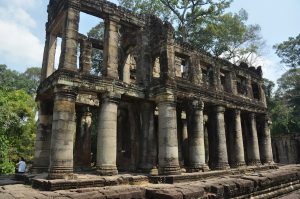 I was absolutely fascinated by this temple and could have stayed there much longer to absorb the atmosphere, to appreciate the artistic shapes that the roots created. It was truly wonderful. These capoc trees help to hold the monument together, while at the same time destroying it. The roots weave their way into cracks and crevices, gradually forcing the stones apart, but, at the same time, acting as the glue that holds them in place. Unfortunately trees do not live forever, and when they die they gradually disintegrate and the walls they supported also crumble.
I was absolutely fascinated by this temple and could have stayed there much longer to absorb the atmosphere, to appreciate the artistic shapes that the roots created. It was truly wonderful. These capoc trees help to hold the monument together, while at the same time destroying it. The roots weave their way into cracks and crevices, gradually forcing the stones apart, but, at the same time, acting as the glue that holds them in place. Unfortunately trees do not live forever, and when they die they gradually disintegrate and the walls they supported also crumble.
 In amongst the mayhem of roots there were some wonderful examples of sculpted stone, displaying an incredible amount of detail that has managed to survive over 1000 years of weather eroding it. There was clearly a very high level of skill among the stone masons of the period. These were not just single stone block carving but multi-block carvings. Behind the carved facade you could see the joints in the blocks behind.
In amongst the mayhem of roots there were some wonderful examples of sculpted stone, displaying an incredible amount of detail that has managed to survive over 1000 years of weather eroding it. There was clearly a very high level of skill among the stone masons of the period. These were not just single stone block carving but multi-block carvings. Behind the carved facade you could see the joints in the blocks behind.
By the time we were ready to leave Ta Prohm, it was time to capitalise on the Chinese going to lunch, giving us an opportunity to view Angkor Wat without too many people. With Angkor Wat, as with all the temples we visited, we approached from one direction and left by another.
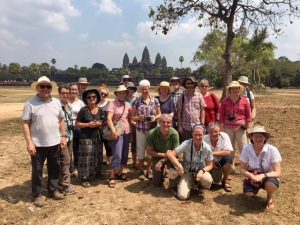 The walk in towards Angkor Wat is quite long, giving us plenty of time to appreciate it as we draw closer. Initially, we had to walk across the narrowest part of the moat on a modern pontoon that led us to the gates of the outer wall. Once through the wall we got a clear view of the temple in all its glory. Sophey was brilliant and kept taking us to 5* photographic points so that we would get the best shots. He was also brilliant in his timing, as this, the largest of all the monuments, was fairly deserted. It meant we could relax and enjoy our visit without having to fight crowds.
The walk in towards Angkor Wat is quite long, giving us plenty of time to appreciate it as we draw closer. Initially, we had to walk across the narrowest part of the moat on a modern pontoon that led us to the gates of the outer wall. Once through the wall we got a clear view of the temple in all its glory. Sophey was brilliant and kept taking us to 5* photographic points so that we would get the best shots. He was also brilliant in his timing, as this, the largest of all the monuments, was fairly deserted. It meant we could relax and enjoy our visit without having to fight crowds.
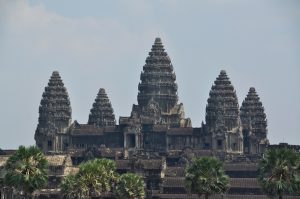 Angkor Wat is the earthly representation of Mt. Meru, the home of the ancient Hindu gods. However, it gradually converted to Buddhism towards the end of the 12thC. But it is not just a temple, it is a city of symmetry, built on an enormous scale and is believed to be the world’s largest religious building. The whole complex is surrounded by a huge moat 200m wide. The temple holds great significance to the people of Cambodia – it is a national symbol and the source of national pride. It must be for it features on the flag. Unlike other sites in the area, Angkor Wat has remained in constant use and has, therefore, not succumbed to the ravages of time and nature.
Angkor Wat is the earthly representation of Mt. Meru, the home of the ancient Hindu gods. However, it gradually converted to Buddhism towards the end of the 12thC. But it is not just a temple, it is a city of symmetry, built on an enormous scale and is believed to be the world’s largest religious building. The whole complex is surrounded by a huge moat 200m wide. The temple holds great significance to the people of Cambodia – it is a national symbol and the source of national pride. It must be for it features on the flag. Unlike other sites in the area, Angkor Wat has remained in constant use and has, therefore, not succumbed to the ravages of time and nature.
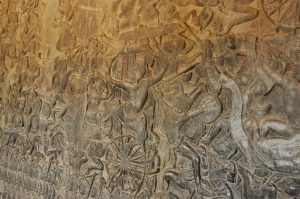 Climbing the steps to the main building, we reached a cloistered corridor or gallery. On the wall were bas-reliefs of ancient stories. These went all the way round the whole structure, each side being 187 metres long. They make the Bayeux Tapestry look like a bit of stitching, they are so complex and detailed.
Climbing the steps to the main building, we reached a cloistered corridor or gallery. On the wall were bas-reliefs of ancient stories. These went all the way round the whole structure, each side being 187 metres long. They make the Bayeux Tapestry look like a bit of stitching, they are so complex and detailed.
Having marvelled at the bas-reliefs, we entered the next level of the temple, a series of square courtyards with deep pools in the middle, although they were now empty of water. By one of the empty pools a boy monk was offering blessings to visitors.
Then we entered the inner courtyard that surrounded the five towers that represent Mt. Meru. Very steep steps led up to higher galleries but these were closed off to visitors. I can imagine that when it is crowded these could be dangerous.
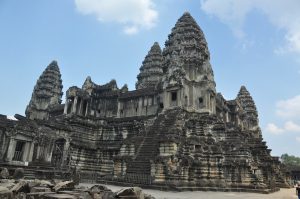 It was truly magnificent, but there was something missing for me. It did not have the fascination of Ta Prohm with its twisted roots intertwining themselves around the stone. It was too perfect. It is its perfection that makes it such an attraction, though. There is nothing quite like it anywhere in the world. It is a tribute to the architectural skills and the visionary of the people who lived in Cambodia at that time, not unlike the architectural skills and vision that was required to build our own cathedrals at around the same time. I suppose the difference is that with Angkor Wat we did not have to use our imagination; it was all there in front of us, whereas, because all the other temples had been in various stages of decay, we had had to be a little more creative in our thoughts.
It was truly magnificent, but there was something missing for me. It did not have the fascination of Ta Prohm with its twisted roots intertwining themselves around the stone. It was too perfect. It is its perfection that makes it such an attraction, though. There is nothing quite like it anywhere in the world. It is a tribute to the architectural skills and the visionary of the people who lived in Cambodia at that time, not unlike the architectural skills and vision that was required to build our own cathedrals at around the same time. I suppose the difference is that with Angkor Wat we did not have to use our imagination; it was all there in front of us, whereas, because all the other temples had been in various stages of decay, we had had to be a little more creative in our thoughts.
It was brilliant and was one of those iconic ‘pinch me’ moments, just to make sure it was real.
By now we were starving, so we took a break for lunch before continuing our temple tour.
The next major temple we were to visit was Angkor Thom but before we did that we stopped briefly at Ta Keo. Not everybody came to see this temple; they were put off by the steep steps, and, indeed, they were incredibly steep and had to be approached with an equal amount of care in going both up and down.
Ta Keo is an unfinished temple. It is built in the ‘mountain’ temple style with several layers approached, as I said before, by steep flights of stairs. Nobody really knows why it was unfinished. It was struck by lightening, which may have been taken as a sign from the gods. Alternatively, it may be because Jayavarman V, who commissioned it, died.
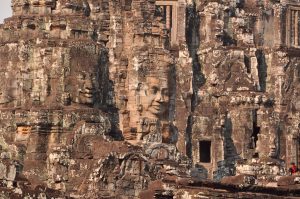 We moved on to Angkor Thom, and from one of Sophey’s 5* photo stops from the edge of the temple area we took photos. As we did so we began to notice a face carved in the stone, then another and another, until we had spotted lots of them. They were incredible. I couldn’t help think that the Reverend Awdry had been here and was inspired by the faces to write his Thomas the Tank Engine stories.
We moved on to Angkor Thom, and from one of Sophey’s 5* photo stops from the edge of the temple area we took photos. As we did so we began to notice a face carved in the stone, then another and another, until we had spotted lots of them. They were incredible. I couldn’t help think that the Reverend Awdry had been here and was inspired by the faces to write his Thomas the Tank Engine stories.
The Bayon Temple at its heart is a complex collection of 54 towers with an amazing collection of 216 demure, smiling faces. As we clambered among the towers and turned corners a stone, smiling face would appear before us. It was beautiful. It was quite crowded on the narrow walkways and on the steep steps leading up and down.
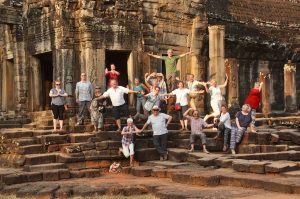 Back at our meeting point, while waiting for a couple of lost members, I organised a group photo among the ruins where each person had to strike a pose. Am I learning from the Chinese how to monopolise an area? However, we were not interfering with anybody else and their enjoyment of the site as we were in a quiet corner. It was enough just to sit there in the cool shade, looking up at the confusion of stone towers, picking out face after face. The colours of the stone were picked out by the sunshine and contrasted well with those in the shade.
Back at our meeting point, while waiting for a couple of lost members, I organised a group photo among the ruins where each person had to strike a pose. Am I learning from the Chinese how to monopolise an area? However, we were not interfering with anybody else and their enjoyment of the site as we were in a quiet corner. It was enough just to sit there in the cool shade, looking up at the confusion of stone towers, picking out face after face. The colours of the stone were picked out by the sunshine and contrasted well with those in the shade.
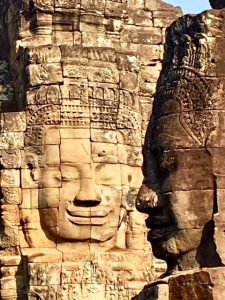 As we left we came across a number of monkeys, including a newly born one playing on one of the walls. They were very endearing and so preoccupied with looking after the baby, they did not worry about us being so close.
As we left we came across a number of monkeys, including a newly born one playing on one of the walls. They were very endearing and so preoccupied with looking after the baby, they did not worry about us being so close.
On our way back to the coach we walked by another temple and along the terrace of elephants. By now my flip flopped feet were not only filthy but quite tired, having walked a lot throughout the day. I was ready to go back to the hotel and flop.
Having cleaned up, I decided to go and enjoy another massage before I left Cambodia. While it was not quite as good as the one I had had previously, I thought it was well worth the US$5 I paid for it.
That evening, we ate in the hotel for the sake of simplicity.
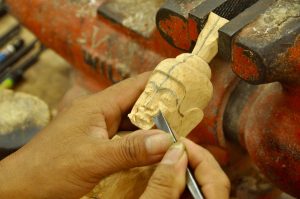 After a leisurely breakfast we were taken to a craft workshop that housed a number of different crafts under one roof. There was coloured grass weaving, candle making, herb and spice blending, wood carving, stone sculpting, painting, jewellery making, metal crafts and lacquer work. It is a great idea having all of these under one roof, as you would expect it to keep the prices down. Looking around in the shop, I’m not sure that this was the case. It was all very beautiful, but I was very conscious that we had no capacity within our luggage to take anything home.
After a leisurely breakfast we were taken to a craft workshop that housed a number of different crafts under one roof. There was coloured grass weaving, candle making, herb and spice blending, wood carving, stone sculpting, painting, jewellery making, metal crafts and lacquer work. It is a great idea having all of these under one roof, as you would expect it to keep the prices down. Looking around in the shop, I’m not sure that this was the case. It was all very beautiful, but I was very conscious that we had no capacity within our luggage to take anything home.
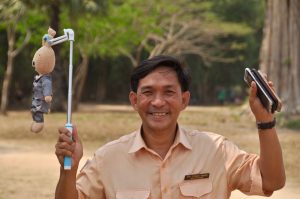 After lunch Sophey took us to the airport for our flight to Luang Prabang and the last phase of our trip. Sophey had been a brilliant guide. He knew exactly how to adjust the itinerary so that we got the best of our short time in Cambodia. He was knowledgeable and his good command of English allowed him to share his knowledge. He made all the difference and I would hope, that if I returned, I would be able to team up with him again.
After lunch Sophey took us to the airport for our flight to Luang Prabang and the last phase of our trip. Sophey had been a brilliant guide. He knew exactly how to adjust the itinerary so that we got the best of our short time in Cambodia. He was knowledgeable and his good command of English allowed him to share his knowledge. He made all the difference and I would hope, that if I returned, I would be able to team up with him again.

